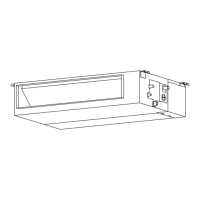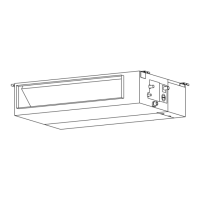
Do you have a question about the Midea MTI-24FNXD0 MOU-24FN1-QD0 and is the answer not in the manual?
| Brand | Midea |
|---|---|
| Model | MTI-24FNXD0 MOU-24FN1-QD0 |
| Category | Air Conditioner |
| Language | English |
Identifies components of the indoor unit.
Important safety guidelines for indoor unit installation.
Step-by-step instructions for installing the indoor unit.
Guidelines for selecting the installation location for the outdoor unit.
Steps for physically mounting the outdoor unit.
Guidance on drilling holes through walls for installation.
Instructions for installing the drain joint for water drainage.
Key considerations for proper drainpipe installation.
Specific steps for installing the drainpipe for the indoor unit.
Procedure to verify the drainpipe system is functioning correctly.
Warnings and precautions for handling refrigerants.
Requirements for pipe length, bends, and drop height.
Specific piping considerations for systems with multiple indoor units.
Guidance on installing oil traps based on unit height difference.
Specifications for maximum total piping length and drop height.
Table detailing pipe sizes for indoor and outdoor units.
Step-by-step guide to connecting refrigerant pipes.
Instructions for properly cutting refrigerant pipes.
Procedure to remove burrs from cut pipe ends for a good seal.
Steps for creating proper flare ends on pipes for connections.
Detailed steps for connecting refrigerant pipes to units.
Critical safety warnings before performing wiring.
Information on fuses for overcurrent protection.
Instructions for wiring the outdoor unit.
Instructions for wiring the indoor unit.
How to use the wire controller for airflow adjustment.
Power requirements for indoor units.
Power requirements for outdoor units.
Power specifications for independent supply.
Power requirements for inverter type air conditioners.
Cautions regarding vacuum pumps and outdoor unit valves.
Step-by-step process for evacuating the system.
Guidelines and formulas for adding refrigerant based on pipe length.
Pre-test checks to ensure proper installation.
Detailed steps for performing the test run.
Safety checks for areas containing flammable refrigerants.
Controlled procedures for working on the system.
Instructions for personnel and workspace safety.
Using detectors to check for flammable atmospheres.
Requirement for fire extinguishing equipment.
Guidelines to prevent ignition sources near refrigerant.
Ensuring adequate ventilation during work.
Ensuring components fit purpose and specifications.
Safety checks for electrical components and wiring.
Procedures for working on sealed components.
Guidelines for working on live intrinsically safe components.
Checking cabling for wear and environmental effects.
Methods for detecting refrigerant leaks safely.
Acceptable methods for detecting refrigerant leaks.
Procedures for removing refrigerant and evacuating the system.
Requirements for safe and effective refrigerant charging.
Procedures for safely decommissioning the unit.
Requirements for labelling de-commissioned equipment.
Procedures for safely recovering refrigerant.
Guidelines for transporting, marking, and storing units.











